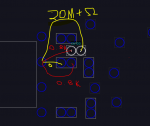Monkey Bytes
New member
I have an 820-3476 Board with supposedly no water damage. I cleaned some corrosion from inside the thunderbolt ports. I found some corrosion near one of the debug connectors, so I removed it. Later I thought it may be a BIOS Issue so I replaced the bios chip.
Initially this board had an orange light (no battery), and the fan would power on for a second or two, turn off, and then repeat. I searched the board and found that the S5 rails were constant while the S0 rails were ALL turning on and off. Otherwise those rails seemed to be exactly as expected. I've checked every current sensing resistor I could find, thinking it was a sensor issue. After a week or so of troubleshooting, the fan no longer spins up. I left it whilst doing the spin-up routine for 10 minutes, came back, and now I'm here.
PPBUS_G3H is 12.5V along with all the ppbus_s5 rails.
pp5v_s0 0v
pp5v_s5 0.9v
pp3v42_g3h 3.41v
The weirdest thing that made me sign up for this forum is that the F7005 18.5V fuse has 0.1ohm resistance, yet has 0V on both sides when plugged in. If I test the pins on the DC Jack connector, they all come back as 0 volts. So either something is terribly wrong or I might just have the secret for infinite energy.
Any advice? I'm now looking to troubleshoot the ISL6259 circuitry to see if maybe it's responsible for my pp5v_s5 problems.
I have the board view, schematic, a donor board, a basic microscope/iron/air station and so forth.
Initially this board had an orange light (no battery), and the fan would power on for a second or two, turn off, and then repeat. I searched the board and found that the S5 rails were constant while the S0 rails were ALL turning on and off. Otherwise those rails seemed to be exactly as expected. I've checked every current sensing resistor I could find, thinking it was a sensor issue. After a week or so of troubleshooting, the fan no longer spins up. I left it whilst doing the spin-up routine for 10 minutes, came back, and now I'm here.
PPBUS_G3H is 12.5V along with all the ppbus_s5 rails.
pp5v_s0 0v
pp5v_s5 0.9v
pp3v42_g3h 3.41v
The weirdest thing that made me sign up for this forum is that the F7005 18.5V fuse has 0.1ohm resistance, yet has 0V on both sides when plugged in. If I test the pins on the DC Jack connector, they all come back as 0 volts. So either something is terribly wrong or I might just have the secret for infinite energy.
Any advice? I'm now looking to troubleshoot the ISL6259 circuitry to see if maybe it's responsible for my pp5v_s5 problems.
I have the board view, schematic, a donor board, a basic microscope/iron/air station and so forth.
Last edited:

